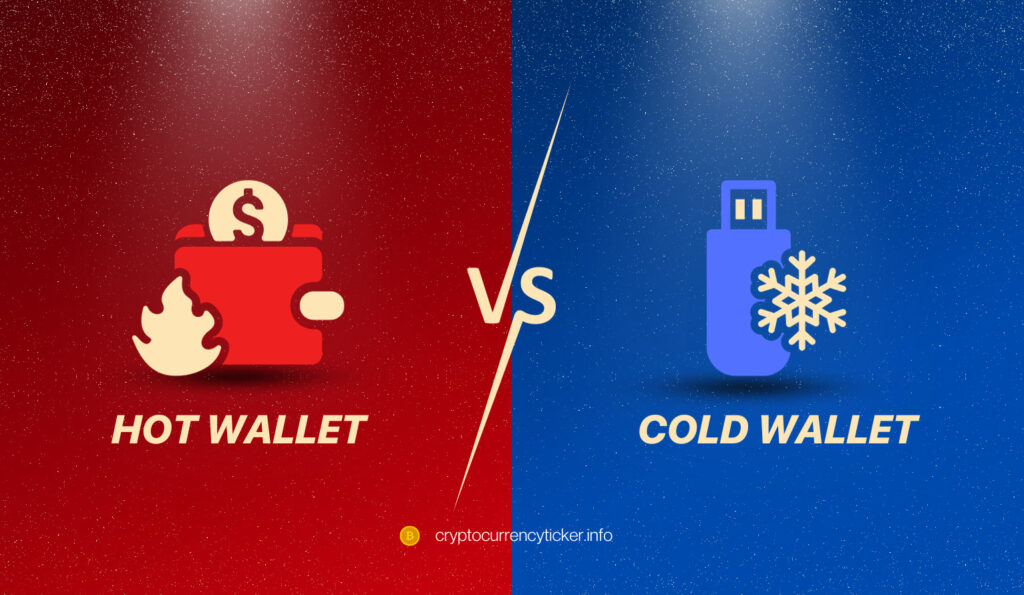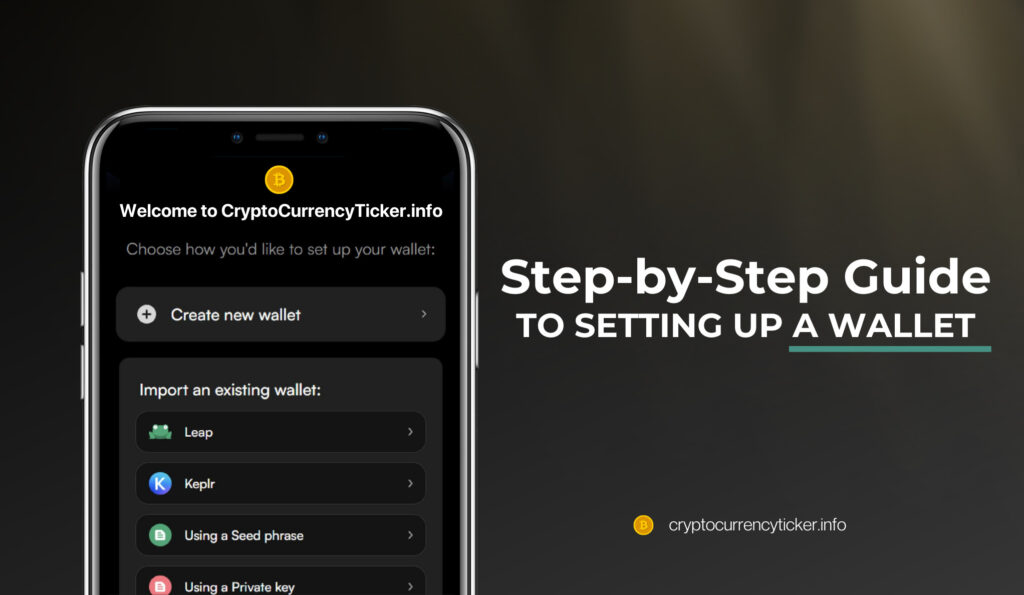Cryptocurrency has revolutionized the way we think about finance and digital transactions. Unlike traditional currencies, cryptocurrencies are digital or virtual currencies that use cryptography for security, making them nearly impossible to counterfeit. The most well-known cryptocurrency is Bitcoin, but there are thousands of others, including Ethereum, Ripple, and Litecoin.
What is Cryptocurrency?
At its core, cryptocurrency is a decentralized digital currency. This means it does not rely on central authorities like governments or banks for regulation. Instead, transactions and the issuance of these digital currencies are carried out collectively by a technology called blockchain. A blockchain is a growing list of records, called blocks, which are linked using cryptography. Each block contains a cryptographic hash of the previous block, a timestamp, and transaction data, making the entire process secure and transparent.
The Role of Wallets in Cryptocurrency Management
A cryptocurrency wallet is not like a physical wallet you carry in your pocket. Instead, it’s a digital tool that allows you to store, send, and receive digital currencies. Most cryptocurrencies have their own official wallet, and there are also third-party wallets that support multiple cryptocurrencies.
Key Functions of a Cryptocurrency Wallet:
- Storage: Wallets store the digital credentials (keys) needed to access your cryptocurrency holdings.
- Transactions: They enable you to send and receive cryptocurrencies through blockchain transactions.
- Security: Wallets offer various security features to protect your digital assets, such as encryption and backup options.
Types of Wallets:
- Hot Wallets: These are connected to the internet and are convenient for frequent transactions. However, they are less secure due to their online nature.
- Cold Wallets: These are offline wallets, more secure but less convenient for regular transactions. They are ideal for storing large amounts of cryptocurrency long-term.
Types of Cryptocurrency Wallets
When venturing into the world of cryptocurrencies, one of the most critical decisions you’ll make is choosing the right type of wallet. Understanding the different types of wallets and their features is essential for ensuring the safety and accessibility of your digital assets.
Hot Wallets vs. Cold Wallets

The primary distinction in cryptocurrency wallets is between hot and cold wallets. This distinction is based on their connection to the internet.
- Hot Wallets:
- Connection: Always connected to the internet.
- Accessibility: High – ideal for frequent trading and transactions.
- Security: Lower than cold wallets, as they are more vulnerable to online threats.
- Examples: Mobile apps, desktop software, online wallets.
- Cold Wallets:
- Connection: Not connected to the internet.
- Accessibility: Lower – more steps to access and use.
- Security: High – less susceptible to online hacking attempts.
- Examples: Hardware wallets, paper wallets.
| Type | Accessibility | Security Level | Best For |
|---|---|---|---|
| Software | High | Moderate | Daily transactions, ease of use |
| Hardware | Moderate | High | Long-term storage, high value |
| Paper | Low | High | Backup, long-term storage |
Software Wallets:
- Description: These are applications that can be installed on your computer or smartphone. They are convenient for regular transactions.
- Pros: Easy to use, quick access.
- Cons: Vulnerable to malware and hacking if the device is compromised.
Hardware Wallets:
- Description: Physical devices that store your cryptocurrency offline. They resemble USB drives.
- Pros: High security, immune to computer viruses.
- Cons: More expensive, less convenient for quick transactions.
Paper Wallets:
- Description: Physical documents that contain your cryptocurrency keys.
- Pros: Completely offline, very secure against online hacking.
- Cons: Can be damaged or lost, not user-friendly for frequent transactions.
Choosing the Right Wallet
The choice of wallet depends on your individual needs:
- For Active Traders: A software wallet on a mobile device or computer offers the convenience and quick access required.
- For Long-Term Investors: A hardware wallet provides enhanced security for large holdings.
- For Extra Security: Using a combination of wallet types, such as a hardware wallet for savings and a software wallet for daily transactions, can offer both security and convenience.
Choosing the Right Wallet for You
Selecting the appropriate cryptocurrency wallet is a crucial step in your digital currency journey. The right wallet not only provides convenience but also ensures the security and accessibility of your assets. Here, we’ll explore the key factors to consider when choosing a wallet and some popular options for beginners.
Key Considerations in Choosing a Wallet
- Security: The primary concern for any cryptocurrency holder. Look for features like two-factor authentication (2FA), multi-signature support, and backup options.
- Convenience: Consider how often you plan to access or use your cryptocurrencies. Daily traders need more accessible wallets, while long-term holders might prioritize security over accessibility.
- Accessibility: Check if the wallet is compatible with your devices and operating systems. Also, consider if it supports the cryptocurrencies you are interested in.
- Reputation and Reliability: Opt for wallets developed by reputable companies with a track record of security and customer support.
- User Interface: Especially important for beginners, the wallet should have an intuitive and easy-to-navigate interface.
| Wallet Name | Type | Best For | Key Features |
|---|---|---|---|
| Exodus | Software | Beginners, Multi-currency | User-friendly, supports multiple cryptocurrencies |
| Ledger Nano S | Hardware | Security, Long-term storage | High security, supports multiple cryptocurrencies |
| Trust Wallet | Mobile | Convenience, Trading | Mobile-based, user-friendly, supports multiple cryptocurrencies |
| MyEtherWallet | Web | Ethereum users | Specifically for Ethereum and ERC-20 tokens, integrates with hardware wallets |
| Electrum | Software | Bitcoin users | Bitcoin-focused, customizable fees, high security |
Your choice of wallet should align with your cryptocurrency usage and security needs. For beginners, starting with a user-friendly software wallet like Exodus or Trust Wallet can be a great introduction. As you become more involved in the crypto world, consider investing in a hardware wallet like Ledger Nano S for enhanced security, especially if you’re holding significant amounts of cryptocurrency.
Step-by-Step Guide to Setting Up a Wallet

Setting up a cryptocurrency wallet is a straightforward process, but it’s crucial to follow each step carefully to ensure your digital assets’ security. Whether you’ve chosen a software, hardware, or mobile wallet, this guide will help you through the setup process.
Downloading and Installing Your Chosen Wallet
- Choose a Reputable Source: Always download wallets from the official website or a verified app store to avoid malicious software.
- Installation:
- For software wallets, run the installer and follow the on-screen instructions.
- For mobile wallets, download the app from your phone’s app store.
- Hardware wallets usually come with a setup guide for installation.
Creating and Securing Your Wallet Account
- Creating a New Wallet:
- Choose the option to create a new wallet.
- Follow the prompts to set up your wallet, which may include creating a username and password.
- Securing Your Wallet:
- Backup Your Wallet: Most wallets will provide you with a recovery phrase. Write this down and store it in a secure location. Never store it digitally to avoid online theft.
- Set a Strong Password: Use a combination of letters, numbers, and symbols.
- Enable Two-Factor Authentication (2FA): If available, this adds an extra layer of security.
- Understanding Your Public and Private Keys:
- Public Key: This is your wallet address, which you will use to receive funds. It’s safe to share this.
- Private Key: This is what you use to access and control your funds. Never share your private key with anyone.
A Note on Wallet Security
- Regularly Update Your Wallet: Keep your wallet software updated to ensure you have the latest security enhancements.
- Be Wary of Phishing Scams: Never enter your private keys or recovery phrases into suspicious websites or emails.
Once you have completed these steps, your wallet is ready to use. You can now receive and send cryptocurrencies. Remember, the security of your wallet is paramount. Regularly review your security settings and stay informed about best practices in cryptocurrency security.
Understanding Wallet Security
Securing your cryptocurrency wallet is crucial in protecting your digital assets from theft and unauthorized access. This section will cover the importance of private keys and backup phrases, along with best practices for maintaining wallet security.
The Importance of Private Keys and Backup Phrases
- Private Keys:
- Definition: A private key is a sophisticated form of cryptography that allows a user to access their cryptocurrency.
- Security: It’s essential to keep your private key secret. Anyone who knows your private key can steal your funds.
- Storage: Never store your private key online or share it. Use secure offline methods like a safety deposit box or a secure home safe.
- Backup Phrases:
- Purpose: Also known as a seed phrase or recovery phrase, it’s used to recover your wallet if your computer or mobile device is lost or damaged.
- Security: Like private keys, backup phrases should be kept secret and stored securely offline.
- Best Practice: Write it down on paper or a metal backup tool and store it in a secure location.
Best Practices for Keeping Your Wallet Secure
- Regular Updates:
- Keep your wallet software updated to the latest version. This ensures you have the latest security patches and improvements.
- Use Secure Networks:
- Avoid using public Wi-Fi when accessing your wallet. Use a secure, private network to prevent unauthorized access.
- Beware of Phishing Scams:
- Be cautious of emails or websites asking for your private keys or recovery phrases. Legitimate services will never ask for these details.
- Consider Multi-Signature Wallets:
- Multi-signature wallets require multiple keys to authorize a transaction, adding an extra layer of security.
- Use a Hardware Wallet for Significant Amounts:
- For larger cryptocurrency holdings, consider using a hardware wallet for enhanced security.
Regular Security Audits
- Check for Vulnerabilities: Regularly review your wallet’s security settings and update your knowledge on the latest security threats.
- Test Your Backup: Periodically ensure that your backup methods are effective and accessible in case of an emergency.
Remember, the security of your cryptocurrency wallet is as strong as your weakest security practice. Regularly educating yourself and adhering to these best practices can significantly reduce the risk of losing your digital assets.
Making Your First Cryptocurrency Transaction

After setting up and securing your wallet, the next step is to initiate your first cryptocurrency transaction. Whether you’re sending or receiving digital currency, understanding the process and what to expect in terms of fees and wait times is crucial. This section will guide you through these aspects.
How to Receive Cryptocurrency
- Locate Your Public Address:
- Every wallet has a unique public address (or QR code) that others use to send you cryptocurrency.
- Find and copy this address from your wallet interface.
- Share Your Public Address:
- Provide this address to the person or service sending you cryptocurrency.
- Remember, only share your public address, not your private key.
- Wait for Confirmation:
- Once the transaction is initiated, it will appear in your wallet as pending.
- Transactions need to be verified by the network, which can take time depending on the cryptocurrency and network congestion.
How to Send Cryptocurrency
- Access Your Wallet:
- Open your wallet and select the option to send cryptocurrency.
- Enter Recipient’s Address:
- Carefully enter the recipient’s public address. Double-check for accuracy, as transactions cannot be reversed.
- Enter the Amount:
- Specify the amount of cryptocurrency you want to send. Be mindful of transaction fees.
- Confirm and Send:
- Review the transaction details, including fees, and confirm the transaction.
- Once confirmed, the transaction will be broadcast to the network for verification.
Understanding Transaction Fees and Wait Times
- Transaction Fees:
- Fees are required to process and confirm transactions on the blockchain.
- Fees can vary based on network congestion and the size of your transaction.
- Some wallets allow you to choose the fee, affecting how quickly the transaction is processed.
- Wait Times:
- Transaction times vary depending on the cryptocurrency and network load.
- Bitcoin transactions can take from 10 minutes to several hours.
- Other cryptocurrencies like Ethereum may have faster processing times.
Tips for a Smooth Transaction
- Always Double-Check Addresses: Mistyped addresses can lead to lost funds.
- Be Aware of Market Volatility: Cryptocurrency prices can fluctuate rapidly.
- Start with Small Amounts: For your first transaction, consider sending a small amount to familiarize yourself with the process.
Making your first cryptocurrency transaction can be exciting. By following these steps and being aware of transaction fees and wait times, you can ensure a smooth and successful experience.
Troubleshooting Common Issues
Even with the most user-friendly cryptocurrency wallets, you may encounter some issues. Understanding how to troubleshoot these problems can save you time and stress. This section covers common issues and their solutions, along with resources for further help.
Common Setup and Usage Problems
- Wallet Installation Issues:
- Problem: Difficulty in installing or opening the wallet.
- Solution: Ensure you’re downloading from the official source. Check your device’s compatibility and update your operating system if necessary.
- Transaction Delays:
- Problem: Transactions taking longer than expected.
- Solution: Check the blockchain network for congestion. If you set a low transaction fee, it might take longer for the transaction to be processed.
- Wallet Synchronization Issues:
- Problem: Wallet taking a long time to synchronize with the blockchain.
- Solution: Ensure a stable internet connection. Some wallets allow you to download a portion of the blockchain for faster sync.
- Forgotten Passwords or Lost Access:
- Problem: Unable to access the wallet due to forgotten credentials.
- Solution: Use your backup phrase to restore your wallet. If you’ve lost your backup phrase, unfortunately, there’s often no way to recover the wallet.
Addressing Security Concerns
- Suspected Hacking or Unauthorized Access:
- Change your wallet’s password immediately.
- Transfer your funds to a new wallet if you suspect your private key is compromised.
- Contact the wallet provider for further assistance.
- Phishing Scams:
- Be vigilant about emails or websites asking for your private keys or recovery phrases.
- Always verify the authenticity of any communication claiming to be from your wallet provider.
Where to Find Help and Resources
- Official Wallet Support: Start with the support section of your wallet’s official website.
- Community Forums: Platforms like Reddit and Bitcointalk can be valuable for advice from experienced users.
- Educational Resources: Websites like CoinDesk and CryptoCompare offer guides and articles on various wallet issues.
While encountering issues can be frustrating, most problems have straightforward solutions. Keeping calm and accessing the right resources can help you resolve any wallet-related challenges effectively.
Conclusion and Next Steps
As we conclude our comprehensive guide on setting up your first cryptocurrency wallet, let’s briefly revisit the essentials. We’ve navigated through understanding cryptocurrencies and the pivotal role of wallets, explored various types of wallets including hot, cold, software, hardware, and paper, and discussed how to choose the right one based on security, convenience, and reliability. The journey included a detailed walkthrough of setting up and securing your wallet, understanding the intricacies of making transactions, and troubleshooting common issues. These foundational steps are crucial in building your confidence and capability in managing digital assets securely and efficiently.
Looking ahead, your cryptocurrency wallet opens the door to a myriad of possibilities. It’s not just a tool for storing digital currencies but a gateway to diversifying your portfolio, engaging in staking or yield farming, exploring the burgeoning world of Decentralized Finance (DeFi), and even delving into the realm of Non-Fungible Tokens (NFTs). As the cryptocurrency landscape continues to evolve, staying informed and updated on the latest trends and security practices is vital. Regularly updating your wallet, following industry news, and continuing your education in this dynamic field will empower you to make the most of your cryptocurrency journey. Remember, the path of digital currency is one of discovery and opportunity – embrace it with curiosity and diligence.
